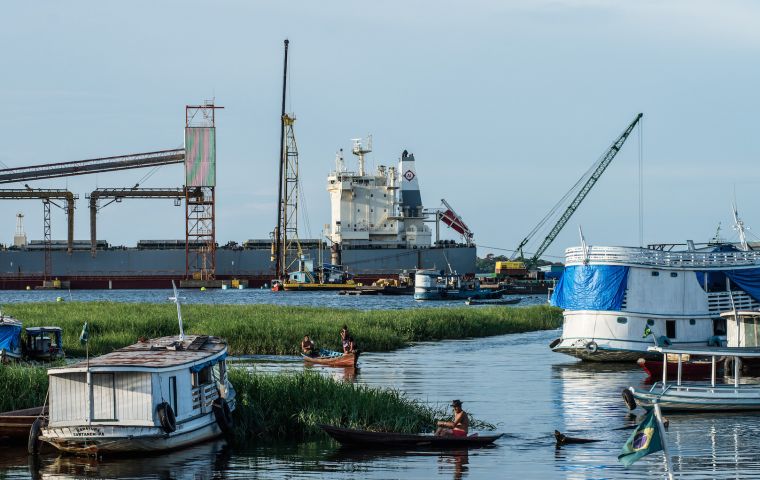MercoPress. South Atlantic News Agency
Brazil improved infrastructure closes supply chain gap with the US in soy exports
 Improving infrastructure in Amazon River, Brazil has slashed two days and 1,000 miles off the time and distance taken to get crops shipped and ready to sail for China
Improving infrastructure in Amazon River, Brazil has slashed two days and 1,000 miles off the time and distance taken to get crops shipped and ready to sail for China A surging dollar and the supply-chain bottlenecks are cutting the competitive edge for United States farmers in the soybeans global market, to the benefit of Brazilian farmers, according to US Department of Agriculture data.
In most years through 2020, it was almost twice as expensive for China, the world's largest importer, to ship Brazilian rather than American soybeans. But logistics issues in the U.S., improved conditions in Brazilian ports for supply infrastructure, and the strong dollar have almost eliminated that competitive gap, points out the U.S. Department of Agriculture.
It now costs roughly the same for a Chinese buyer to transport a ton of soybeans from Brazil’s biggest-growing state of Mato Grosso as it does from the US state of Iowa.
While the U.S. — which vies with Brazil as the world’s biggest soybean producer — races to remedy pandemic-era transport backlogs and kicks off a multi-billion-dollar plan to upgrade cranky infrastructure, Brazil is already starting to reap the fruits of more than 290 billion Reais (some US$ 56.1 billion) the federal government has invested in roads and maritime gateways since 2008.
“Nothing stimulates more than competition — and this is a fierce competition,” said Mike Steenhoek, the executive director for the Soy Transportation Coalition. “When you see that kind of improvement in other places, we need to increase investments in our country.”
Time is essential for the U.S., which lost about US$ 10 billion in agricultural exports because of the pandemic-era supply-chain disruptions, according to an April paper by University of California at Davis, professor Colin Carter, together with University of Connecticut assistant professor Sandro Steinbach, and doctoral student Xiting Zhuang.
Brazil, meanwhile, is seeing dividends from its investment — the revamp of the so-called Northern Arc of ports along the Amazon River and northeastern Atlantic Ocean coast has slashed two days and 1,000 miles off the time and distance taken to get crops from mid-western farms to a ship — about half of what it was before.
Down south at Brazil’s busiest port — Santos — authorities are investing hundreds of millions of dollars to upgrade total capacity by about half to 240 million tons annually in 2040, while the total amount of cargo moved by train will almost double to 86 million tons per year, said Bruno Stupello, the business development director at the gateway.
The US federal infrastructure package passed in 2021 has promised big logistics investments, including US$ 17 billion for ports and tens of billions more for rail and roads. At the same time, the US maritime hubs plan to invest almost US$ 33 billion annually by 2025.
While the U.S. has supply-chain snarls to tackle, it remains an easier place to move products to ports relative to Brazil, Steenhoek of the Soy Transportation Coalition points out.
But even with all the investment, only time will tell if Brazil will establish itself as a cheaper option, said Joana Colussi, an agricultural researcher at the University of Illinois -in Urbana- Champaign. “Despite recent advances, logistical challenges are likely to persist in Brazil in the coming years because of infrastructure deficits,” she said.




Top Comments
Disclaimer & comment rulesCommenting for this story is now closed.
If you have a Facebook account, become a fan and comment on our Facebook Page!